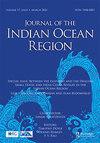Introduction: Indianoceanness and its Indo-Pacific dimensions
IF 0.9
Q2 AREA STUDIES
引用次数: 0
Abstract
There is a growing appreciation by both academia and policymakers in the Indian Ocean region, and beyond, that proactively engaging with the wider Indo-Pacific region –a vast maritime region of overlapping sub-regions– is no longer a matter of choice but a necessity. Several contributions to the past editions of the Journal of the Indian Ocean Region (JIOR) have underlined the importance of pluralizing the construct of Indo-Pacific while retaining the exceptionalism of Indianoceanness. There has been a growing acceptance and acknowledgement at the same time that the return and rise of the Indo-Pacific (Doyle & Rumley, 2020) will continue to be perceived differently from diverse geopolitical, geoeconomic and geostrategic locations. A mature and mutually shared understanding of where, how and when national interests converge, and/or diverge, bodes well for the future of multilateralism in general and regional cooperation in particular in this region. What provides unity in the midst of diverse perceptions, policies and positions of multiple stakeholders is the awareness that the maritime domain –as highlighted by the UN Ocean Decade– is a medium that forces us to think innovatively about sovereignty, security and sustainability. Given the very nature of the World Ocean, (in)security and (un)sustainability for anyone and anywhere amounts to (in)security and (un)sustainability for everyone and everywhere. Therefore, a rigid understanding of the inside/outside of maritime regions and sub-regions remains convoluted and contested. Once realized, the awareness of unity in diversity should enable us to map out commonalities and convergences in apparently diverse –at times divergent– national positions on what Indo-Pacific stands –or should stand—for. Sustainable ocean development and effective ocean governance need cooperation across multiple sectors and scales that could –and should— facilitate a new maritime regionalism in the Indian Ocean, with the sub-regional scale playing an important complementary role in ensuring that the living habitat of both humans and non-humans remains free from international discord and geopolitical rivalries. In the commonly shared, forward-looking vision of an open, rule-based, inclusive, peaceful and socially just maritime order for the Indian Ocean and the wider Indo-Pacific space, there are no winners and losers per se. Readers may recall several scholarly contributions published in the past editions of JIOR on a highly complex yet extremely compelling subject of ‘connectivity’, such as in the special issue focusing on the Bay of Bengal (Basu Ray Chaudhury & Chatterji, 2019). What we are dealing with here is a basket of issues related to ‘Contentious Connectivity’ (Gaens & Sinkkonen, 2023). In the ongoing epistemic battle between reductionist accounts of connectivity based on wild generalizations and speculations, and, meticulously researched theoretically robust and empirically engaged case studies, the JIOR remains committed to the pursuit and promotion of the latter. The first contribution to the current edition of JIOR by Pradhan, Rathi and Gupta, ‘Sagarmala & India’s maritime big push approach: seaports as India’s geoeconomic gateways & neighborhood maritime lessons’, offers a detailed and insightful analysis of India’s emerging maritime governance architecture, with special reference to Sagarmala; a project with considerable引言:印度洋清洁度及其印度-太平洋维度
印度洋地区及其他地区的学术界和政策制定者越来越认识到,积极参与更广泛的印度洋-太平洋地区(一个由重叠的次区域组成的广阔海洋地区)不再是一个选择问题,而是一种必要。过去几期《印度洋地区期刊》(Journal of the Indian Ocean Region,简称JIOR)的几篇文章都强调了印度-太平洋多元化建设的重要性,同时保留了印度海洋的例外主义。与此同时,越来越多的人接受和承认,印度太平洋地区的回归和崛起(Doyle & Rumley, 2020)将继续被不同的地缘政治、地缘经济和地缘战略位置所感知。对各国利益在何处、如何以及何时趋同或分歧有成熟和共同的认识,对多边主义的总体前景,特别是对本地区的区域合作来说,是一个好兆头。在多个利益攸关方的不同看法、政策和立场中,让我们保持一致的是,我们认识到,正如联合国海洋十年所强调的那样,海洋领域是一个媒介,迫使我们以创新的方式思考主权、安全和可持续性问题。鉴于世界海洋的本质,任何人、任何地方的(非)安全与(非)可持续性等于每个人、任何地方的(非)安全与(非)可持续性。因此,对海洋区域和次区域的内部/外部的严格理解仍然令人费解和有争议。一旦意识到这一点,多样性中的统一应该使我们能够在明显不同(有时是分歧)的国家立场上,就印太代表什么或应该代表什么,绘制出共同点和共同点。可持续的海洋发展和有效的海洋治理需要跨多个部门和规模的合作,这些合作可以而且应该促进印度洋新的海洋区域主义,次区域规模在确保人类和非人类的生存栖息地免受国际纷争和地缘政治对抗方面发挥重要的补充作用。在构建开放、基于规则、包容、和平、社会公正的印度洋和印太空间海洋秩序的共同愿景中,没有赢家和输家。读者可能还记得在JIOR过去的版本中发表的几篇关于高度复杂但极具吸引力的“连通性”主题的学术文章,例如关于孟加拉湾的特刊(Basu Ray Chaudhury & Chatterji, 2019)。我们在这里要处理的是与“有争议的连接性”相关的一篮子问题。在基于疯狂的概括和推测的连通性的还原论账户之间正在进行的认知之争中,以及对理论健全和经验参与的案例研究的精心研究中,JIOR仍然致力于追求和促进后者。Pradhan, Rathi和Gupta对本期JIOR的第一个贡献是“Sagarmala和印度的海事大推动方法:海港作为印度的地缘经济门户和邻里海事经验”,对印度新兴的海事治理架构进行了详细而深刻的分析,特别提到了Sagarmala;一个具有相当规模的项目
本文章由计算机程序翻译,如有差异,请以英文原文为准。
求助全文
约1分钟内获得全文
求助全文

 求助内容:
求助内容: 应助结果提醒方式:
应助结果提醒方式:


